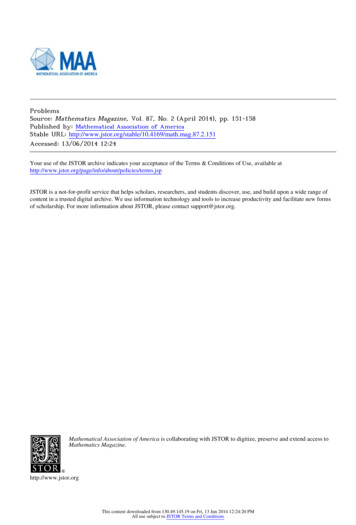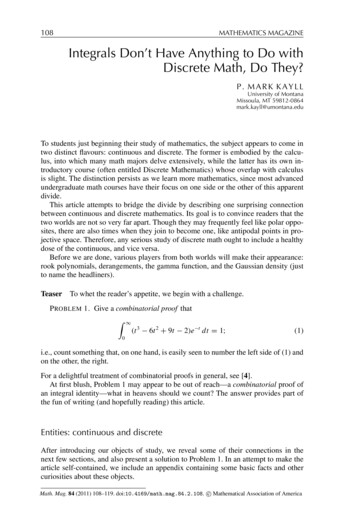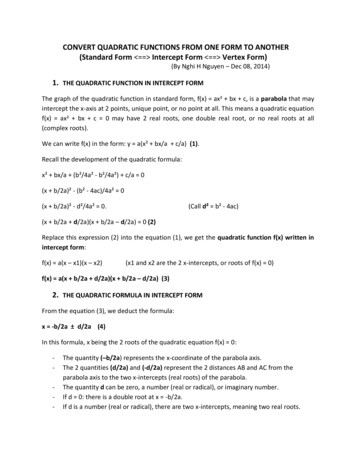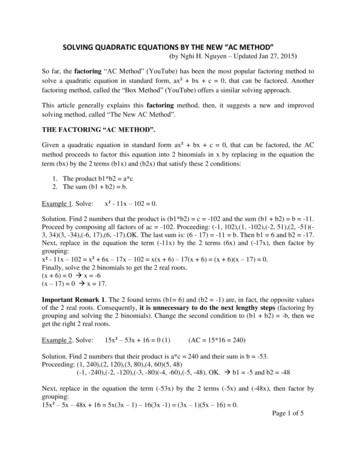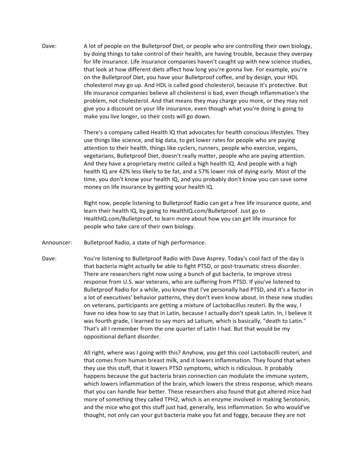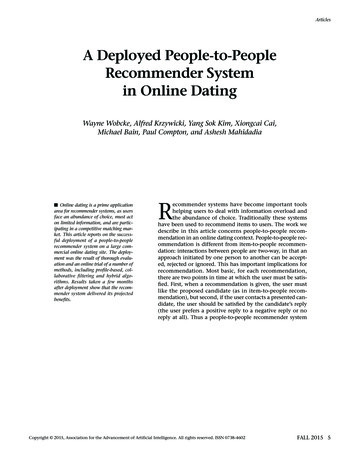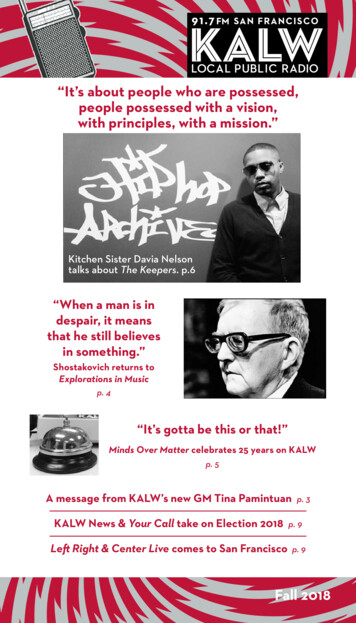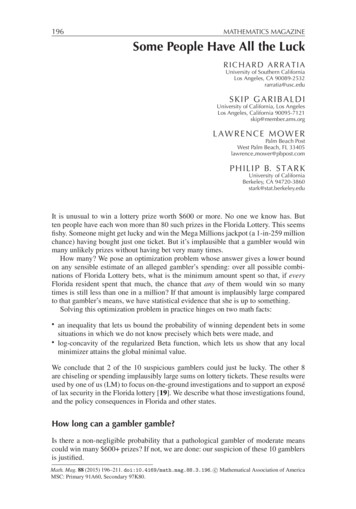
Transcription
196MATHEMATICS MAGAZINESome People Have All the LuckRICHARD ARRATIAUniversity of Southern CaliforniaLos Angeles, CA 90089-2532rarratia@usc.eduSKIP GARIBALDIUniversity of California, Los AngelesLos Angeles, California 90095-7121skip@member.ams.orgLAWRENCE MOWERPalm Beach PostWest Palm Beach, FL 33405lawrence mower@pbpost.comP H I L I P B. S T A R KUniversity of CaliforniaBerkeley, CA 94720-3860stark@stat.berkeley.eduIt is unusual to win a lottery prize worth 600 or more. No one we know has. Butten people have each won more than 80 such prizes in the Florida Lottery. This seemsfishy. Someone might get lucky and win the Mega Millions jackpot (a 1-in-259 millionchance) having bought just one ticket. But it’s implausible that a gambler would winmany unlikely prizes without having bet very many times.How many? We pose an optimization problem whose answer gives a lower boundon any sensible estimate of an alleged gambler’s spending: over all possible combinations of Florida Lottery bets, what is the minimum amount spent so that, if everyFlorida resident spent that much, the chance that any of them would win so manytimes is still less than one in a million? If that amount is implausibly large comparedto that gambler’s means, we have statistical evidence that she is up to something.Solving this optimization problem in practice hinges on two math facts: an inequality that lets us bound the probability of winning dependent bets in somesituations in which we do not know precisely which bets were made, andlog-concavity of the regularized Beta function, which lets us show that any localminimizer attains the global minimal value.We conclude that 2 of the 10 suspicious gamblers could just be lucky. The other 8are chiseling or spending implausibly large sums on lottery tickets. These results wereused by one of us (LM) to focus on-the-ground investigations and to support an exposéof lax security in the Florida lottery [19]. We describe what those investigations found,and the policy consequences in Florida and other states.How long can a gambler gamble?Is there a non-negligible probability that a pathological gambler of moderate meanscould win many 600 prizes? If not, we are done: our suspicion of these 10 gamblersis justified.c Mathematical Association of AmericaMath. Mag. 88 (2015) 196–211. doi:10.4169/math.mag.88.3.196. MSC: Primary 91A60, Secondary 97K80.
197VOL. 88, NO. 3, JUNE 2015So, suppose a gambler starts with a bankroll of S0 and buys a single kind of lotteryticket over and over again. If he spends his initial bankroll and all his winnings, howmuch would he expect to spend in total and how many prizes would he expect to collectbefore going broke?Let the random variable X denote the value of a ticket, payoff minus cost. Weassume thatE(X ) 0,(1)because that is the situation in the games where our suspicious winners claimed prizes.(It does infrequently happen that lottery tickets can have positive expectation, see [14]or [1].) Assumption (1) and the Law of Large Numbers say that a gambler with a finitebankroll eventually will run out of money, with probability 1. The question is: howfast?Write c 0 for the cost of the ticket, so thatP(X c) 1andP(X c) 0.(2)To illustrate our assumptions and notation, let’s look at a concrete example of a Floridagame, Play 4. It is based on the numbers or policy game formerly offered by organizedcrime, described in [16] and [22]. Variations on it are offered in most states that havea lottery.Example 1. (Florida’s Play 4 game) Our ten gamblers claimed many prizes inFlorida’s Play 4 game, although in 2012 it only accounted for about 6% of the FloridaLottery’s 4.45 billion in sales. Here are the rules, simplified in ways that don’t changethe probabilities.The Lottery draws a 4-digit random number twice a day. A gambler can bet on thenext drawing by paying c 1 for a ticket, picking a 4-digit number, and choosing“straight” or “box.”If the gambler bets “straight,” she wins 5000 if her number matches the next 4-digitnumber exactly (which has probability p 10 4 ). She wins nothing otherwise. Theexpected value of a straight ticket is E(X ) 5000 10 4 1 0.50.If a gambler bets “box,” she wins if her number is a permutation of the digits in thenext 4-digit number the Lottery draws. She wins nothing otherwise. The probability ofwinning this bet depends on the number of distinguishable permutations of the digitsthe gambler selects.For instance, if the gambler bets on 1112, there are 4 possible permutations, 1112,1121, 1211, and 2111. This bet is a “4-way box.” It wins 1198 with probability1/2500 4 10 4 , since 4 of the 10,000 equally likely outcomes are permutationsof those four digits. If the gambler bets on 1122, there are 6 possible permutations ofthe digits; this bet is called a “6-way box.” It wins 800 with probability 6 10 4 .(The 6-way box is relatively unpopular, accounting for less than 1% of Play 4 tickets.)Buying such a ticket has expected value E(X ) 0.52. Similarly, there are 12-wayand 24-way boxes.In the abstract setting, the gambler’s bankroll after t bets isSt : S0 X 1 X 2 · · · X t ,where X 1 , . . . , X t are i.i.d. (independent, identically distributed) random variableswith the same distribution as X , and X i is the net payoff of the ith ticket. The gamblercan no longer afford to keep buying tickets after the T th one, where T is the smallestt 0 for which St c.
198MATHEMATICS MAGAZINEProposition 1. In the notation of the preceding paragraph,S0S0 c E(T ) , E(X ) E(X ) with equality on the right if S0 and all possible values of X are integer multiples of c.In most situations, S0 is much larger than c, and the two bounds are almost identical.In expectation, the gambler spends a total of cE(T ) on tickets, including all of hiswinnings, which amount to cE(T ) S0 .Proof. By the definition of T and (2),0 E(ST ) c,(3)with equality on the left in case S0 and X are integer multiples of c. Now the crux isto relate E(T ) to E(ST ). If T were constant (instead of random), then T ET and wecould simply write ET E(ST ) E S0 X i S0 E(T ) E(X ).(4)i 1Combining (4) with (3) would give the claim. The key is that equation (4) holds eventhough T is random—this is Wald’s equation (see, e.g., [9, §5.4]). The essential property is that T is a stopping time, i.e., for every k 0, whether or not one places a kthbet is determined just from the outcomes of the first k 1 bets.You might recognize that in this discussion that we are considering a version of thegambler’s ruin problem but with an unfair bet and where the house has infinite money;for bounds on gambler’s ruin without these hypotheses, see, e.g., [10].A ticket with just one prize The proposition lets us address the question from thebeginning of this section. Suppose a ticket pays j with probability p and nothing otherwise; the expected value of the ticket, E(X ) pj c, is negative; and j is an integermultiple of c. If a gambler starts with a bankroll of S0 and spends it all on tickets, successively using the winnings to buy more tickets, then by Proposition 1 the gamblershould expect to buy E(T ) S0 /(c pj) tickets, which means winningpS0cE(T ) S0 .jc pjprizes.Example 2. How many prizes might a compulsive gambler of “ordinary” meansclaim? Surely some gamblers have lost houses, so let us say he starts with a bankrollworth S0 175,000, an amount between the median list price and the median saleprice of a house in Florida [24]. If he always buys Play 4 6-way box tickets and recycles his winnings to buy more tickets, the previous paragraph shows that he can expectto win aboutpS0 /(c pj) 6 17.5/0.52 202 times.This is big enough to put him among the top handful of winners in the history of theFlorida lottery.Hence, the number of wins alone does not give evidence that a gambler cheated.We must take into account the particulars of the winning bets.
VOL. 88, NO. 3, JUNE 2015199A toy version of the problemFrom here on, a “win” means a win large enough to be recorded; for Florida, thethreshold is 600. Suppose for the moment that a gambler only buys one kind of lotteryticket, and that each ticket is for a different drawing, so that wins are independent.Suppose each ticket has probability p of winning.A gambler who buys n tickets spends cn and, on average, wins np times. This isintuitively obvious, and follows formally by modeling a lottery bet as a Bernoulli trialwith probability p of success: in n trials we expect np successes.We don’t know n, and the gambler is unlikely to tell us. But based on the calculationin the preceding paragraph, we might guess that a gambler who won W times boughtroughly W/ p tickets. Indeed, an unbiased estimate for n is n̂ : W/ p, correspondingto the gambler spending cn̂ on tickets. Since p is very small, like 10 4 , the number n̂is big—and so is the estimated amount spent, cn̂. (Note that this estimate includes anywinnings “reinvested” in more lottery tickets.)A gambler confronted with n̂ might quite reasonably object that she is just verylucky, and that the true number of tickets she bought, n, is much smaller. Under theassumptions in this section, her tickets are i.i.d. Bernoulli trials, and the number ofwins W has a binomial distribution with parameters n and p, which lets us check theplausibility of her claim by consideringn n kprobabilityofatleastw (5)p (1 p)n k .D(n; w, p) : wins with n ticketskk wModeling a lottery bet as a Bernoulli trial is precisely correct in the case of gameslike Play 4. But for scratcher games, there is a very large pool from which the gambleris sampling without replacement by buying tickets; as the pool is much larger thanthe values of n that we will consider, the difference between drawing tickets with andwithout replacement is negligible.Example 3. (Louis Johnson) Of the 10 people who had won more than 80 prizes eachin the Florida Lottery, the second most-frequent prize claimant was Louis Johnson. Heclaimed W 57 5,000 prizes from straight Play 4 tickets (as well as many prizesin many other games that we ignore in this example). We estimate that he boughtn̂ W/ p 570,000 tickets at a cost of 570,000.What if he claimed to only have bought n 175,000 tickets? The probability ofwinning at least 57 times with 175,000 tickets isD(175000; 57, 10 4 ) 6.3 10 14 .For comparison, by one estimate there are about 400 billion stars in our galaxy [15].Suppose there were a list of all those stars, and two people independently pick a starat random from that list. The chance they would pick the same star is minuscule, yet itis still 40 times greater than the probability we just calculated. It is utterly implausiblethat a gambler wins 57 times by buying 175,000 or fewer tickets.What this has to do with Joe DiMaggioThe computation in Example 3 does not directly answer whether Louis Johnson islucky or up to something shady. The most glaring problem is that we have calculatedthe probability that a particular innocent gambler who buys 175,000 of Play 4 ticketswould win so many times. The news media have publicized some lottery coincidences
200MATHEMATICS MAGAZINEas astronomically unlikely, yet these coincidences have turned out to be relatively unsurprising given the enormous number of people playing the lottery; see, for example,[7, esp. p. 859] or [23] and the references therein.Among other things, we need to check whether so many people are playing Play 4so frequently that it’s reasonably likely at least one of them would win at least 57 times.If so, Louis Johnson might be that person, just like with Mega Millions: no particularticket has a big chance of winning, but if there are enough gamblers, there is a bigchance someone wins.We take an approach similar to how baseball probability enthusiasts attempt toanswer the question, Precisely how amazing was Joe DiMaggio? Joe DiMaggio isfamous for having the longest hitting streak in baseball: he hit in 56 consecutive gamesin 1941. (The modern player with the second longest hitting streak is Pete Rose, whohit in 44 consecutive games in 1978.) One way to frame the question is to consider theprobability that a randomly selected player gets a hit in a game, and then estimate theprobability that there is at least one hitting streak at least 56 games long in the entirehistory of baseball. If a streak of 56 or more games is likely, then the answer to thequestion is “not so amazing”; DiMaggio just happened to be the person who had theunsurprisingly long streak. If it is very unlikely that there would be such a long streak,then the answer is: DiMaggio was truly amazing. (The conclusions in DiMaggio’s casehave been equivocal, see the discussion in [13, pp. 30–38].)Let’s apply this reasoning to Louis Johnson’s 57 Play 4 wins (Example 3). Supposethat N gamblers bought Play 4 tickets during the relevant time period, each of whomspent at most 175,000. Then an upper bound on the probability that at least one suchgambler would win at least 57 times is the chance of at least one success in N Bernoullitrials, each of which has probability no larger than p 6.3 10 14 of success. (LouisJohnson represents a success.) The trials might not be independent, because differentgamblers might bet on the same numbers for the same game, but the chance that atleast one of the N gamblers wins at least 57 times is at most N p by the Bonferroni NNbound (for any set of events A1 , . . . , A N , P( i 1Ai ) i 1P(Ai )).What is N ? Suppose it’s the current population of Florida, approximately 19 million. Then the chance at least one person would win at least 57 times is no larger than19 106 6.3 10 14 0.0000012, just over one in a million.This estimate is crude because the estimated number of gamblers is very rough andof course the estimate is not at all sharp (it gives a lot away in the direction of makingthe gambler look less suspicious) because most people spend nowhere near 175,000on the lottery. We are giving even more away because Louis Johnson won many otherbets (his total winnings are, of course, dwarfed by the expected cash outlay). Considering all these factors, one might reasonably conclude that either Louis Johnson has asource of hidden of money—perhaps he is a wealthy heir with a gambling problem—orhe is up to something.Example 4. (Louis Johnson 2) In Example 3 we picked the 175,000 spending levelalmost out of thin air, based on Florida house prices as in Example 2. Instead of startingwith a limit on spending and deducing the probability of a number of wins, let’s startwith a probability, ε 5 10 14 , and infer the minimum spending required to have atleast that probability of so many wins.If Johnson buys n tickets, then he wins at least 57 times with probability D(n; 57,10 4 ). We compute n 0 , the smallest n such thatD(n; 57, 10 4 ) ε,which gives n 0 174,000.
201VOL. 88, NO. 3, JUNE 2015Using the Bonferroni bound again, we find that the probability, if everyone inFlorida spent 174,000 on straight Play 4 tickets, the chance that any of them wouldwin 57 times or more is less than one in a million.Multiple kinds of ticketsReal lottery gamblers tend to wager on a variety of games with different odds of winning and different payoffs. Suppose they place b different kinds of bets. (It might feelmore natural to say “games,” but a gambler could place several dependent bets on asingle Play 4 drawing: straight, several boxes, etc.)Number the bets 1, 2, . . . , b. Bet i costs ci dollars and has probability pi of winning. The gambler won more than the threshold on bet i wi times. We don’t known i , the number of times the gambler wagered on bet i. If we did know the vectorn (n 1 , n 2 , . . . , n b ), then we might be able to calculate the probability: probability of winning at least wi times on bet i with.(6)P( n ; w, p ) : n i tickets, for all iAs in Example 4, we can find a lower bound on the amount spent to attain wi wins onbet i, i 1, . . . , b, by solvingc · n min c · n n such thatn i wiandP( n ; w, p ) ε.(7)For a typical gambler that we study, this lower bound c · n will be in the millionsof dollars. Thinking back to the “Joe DiMaggio” justification for why (7) is a lowerbound, it is clear that not every resident of Florida would spend so much on lotterytickets, and our gut feeling is that a more refined justification would produce a largerlower bound for the amount spent.But how can we find P( n ; w, p )? If the different bets were on independent events(say, each bet is a different kind of scratcher ticket), thenbP( n ; w, p ) i 1 probability of winning at least wi times on bet i with n i ticketsbD(n i ; wi , pi ).(8)i 1But gamblers can make dependent bets, in which case (8) does not hold. Fortunately,it is possible to derive an upper bound for the typical case, as we now show.No dependent wins is almost as good as independent betsFor most of the 10 gamblers, we did not observe wins on dependent bets, such as a winon a straight ticket and a win on a 4-way box ticket for the same Play 4 drawing. Weseek to prove Proposition 2 (below), which gives an upper bound on the probabilitythat we observe at least so many wins but no wins on dependent bets.Abstractly, we envision a finite number d of independent drawings, such as asequence of Play 4 drawings. For each drawing j, j 1, . . . , d, the gambler maybet any amount on any of b different bets (such as 1234 straight, 1344 6-way box,etc.), whose outcomes—for drawing j—may be dependent, but whose outcomes ondifferent draws are independent. We write pi for the probability that a bet on i wins inany particular drawing; pi is the same for all drawings j.For i 1, . . . , b and j 1, . . . , d, let n i j {0, 1} be the indicator that the gamblerwagered on bet i in drawing j, so that ith row sum, n i : j n i j , is the total number
202MATHEMATICS MAGAZINEof bets on i. We call the entire system of bets B, represented by the b-by-d zero-onematrix B [n i j ].Proposition 2. Suppose that, for each i, a gambler wagers on bet i in n i differentdrawings, as specified by B, above. Given the bets B, consider the eventsWi : (gambler wins bet i at least wi times with bets B),and the eventI : (in each drawing j, the gambler wins at most one bet).ThenbP(I W1 · · · Wb ) P(Wi ).(9)i 1In our case, P(Wi ) D(n i ; wi , pi ), so we restate (9) asbP(I W1 · · · Wb ) D(n i ; wi , pi ).(10)i 1Proposition 2 is intuitively plausible: even though the bets are not independent,the drawings are, and event I guarantees that any single drawing helps at most oneof the events {Wi } to occur. We prove Proposition 2 as a corollary of an extensionof a celebrated result, the BKR inequality, named for van den Berg–Kesten–Reimer,conjectured in [4], and proved in [21] and [3] (or see [5]). The remainder of this sectionprovides the details. The original BKR inequality is stated as Theorem 1. We separatethe purely set-theoretic aspects of the discussion, from the probabilistic aspects.The BKR operation Let S be an arbitrary set, and write S d for the Cartesianproduct of d copies of S. Since our application is probability, we call an elementω (ω1 , . . . , ωd ) S d an outcome, and we call any A S d an event.For a subset J {1, . . . , d} and an outcome ω S d , the J -cylinder of ω,denoted (J, ω), is the collection of ω S d such that ω j ω j for all j J . Forevents A1 , A2 , . . . , Ab , let A1 A2 · · · Ab S d be the set of ω for which thereexist pairwise disjoint J1 , J2 , . . . , Jb {1, . . . , d} such that (Ji , ω) Ai for all i. Thecase b 2, where one combines just two events, is the context for the original BKRinequality as in [4, p. 564]; the operation with b 2 is new and is the main study ofthis section.Here is another definition of that might be more transparent. Given an eventA S d and a subset J {1, . . . , d}, define the event[A] J : {ω A (J, ω) A} {ω (J,ω) A}(J, ω).Informally, [A] J consists of the outcomes in A, such that by looking only at the coordinates indexed by J , one can tell that A must have occurred. Evidently, for A, B S d ,A B implies [A] J [B] JandThe definition of becomes Ai : 1 i bpairwise disjoint J1 , . . . , Jb {1, . . . , d}J K implies [A] J [A] K .(11)[A1 ] J1 [A2 ] J2 · · · [Ab ] Jb .(12)
VOL. 88, NO. 3, JUNE 2015203 We read the above definition as “ 1 i b Ai is the event that all b events occur, with bdisjoint sets of reasons to simultaneously certify the b events.” Informally, the outcomeω, observed only on the coordinate indices in Ji , supplies the “reason” that we cancertify that event Ai occurs.Our notation 1 i b Ai A1 A2 · · · Ab is intentionally analogous to the notations for set intersection, 1 i b Ai A1 A2 · · · Ab , and set union, 1 i b Ai A1 A2 · · · Ab . The multi-input operator is, like set intersectionand setunion , fully commutative, i.e., unchanged by any re-ordering of the inputs. Unlikeintersection and union, is not associative, as we now show.Example 5. Take S {0, 1}, d 3, andA (0, , ) (1, 0, ),B (0, , ) (1, 1, ),C ( , 0, 1),where we write for example (1, 0, ) {(1, 0, 0), (1, 0, 1)} ({1, 2}, (1, 0, s)) fors 0, 1 and (0, , ) {(0, 0, 0), (0, 0, 1), (0, 1, 0), (0, 1, 1)}. Note that A B 6. Then A B (0, , ), (A B) C {(0, 0, 1)}—using J1 {1} andJ2 {2, 3} in (12)—but B C {(0, 0, 1)} and A (B C) . Also,A B C .The connection between lottery drawings and Before continuing to discuss theBKR operation in the abstract, we consider what it means for lottery drawings. Wetake S {0, 1, . . . , 2b 1} to encode the results of a single draw: an element s Sanswers, for each of the b bets, whether that bet wins or not. The sample space for ourprobability model is S d ; the jth coordinate ω j reports the results of the b bets on thejth draw.It is easy to see that, in the notation of Proposition 2,(I W1 · · · Wb ) b Wi .(13)1Indeed, given an outcome ω I W1 · · · Wb , we can take, for i 1 to b,Ji : { j on draw j, bet i wins and n i j 1}. Since ω I , the sets J1 , . . . , Jb are mutually disjoint; and since ω Wi , Ji n i . Hence, (Ji , ω) Wi , and thus ω [Wi ] Ji ,for i 1 to b.Example 6. The left hand side of (13) can be a strict subset of the right hand side. Forexample, with b 2 bets and d 2 draws, suppose that w1 w2 1 and the gamblerlays both bets on both draws. The outcome where both bets win on both draws is notin the left side of (13) but is in W1 W2 .To write this example out fully, we think of the binary encoding, S {0, 1, 2, 3}corresponding to {00, 01, 10, 11}, so that, for example, 0 S represents a draw whereboth bets lose, 1 S represents the outcome 01 where the first bet loses and the secondbet wins, 2 S represents the outcome 10 where the first bet wins and the second betloses, and 3 S represents the outcome 11 where both bets win.The event I is the set of ω (ω1 , ω2 ) for which no coordinate ω j is equal to 3. Theevent W1 is the set of ω such that at least one of the coordinates is equal to 2 or 3, andthe event W2 is the set of ω such that at least one of the coordinates is equal to 1 or 3.Certainly,I W1 W2 {(1, 2), (2, 1)},yetW1 W2 {(1, 2), (2, 1), (1, 3), (2, 3), (3, 1), (3, 2), (3, 3)}.
204MATHEMATICS MAGAZINESet theoretic considerations related to the BKR inequality It is obvious that, forevents B1 , . . . , Br S d and J {1, · · · , d}, Bi [Bi ] J andBi [Bi ] J .(14)1 i rJ1 i r1 i rJ1 i rFor unions, the containment may be strict, as in Example 5, where A B S d hence[A B]{1} S d , whereas [A]{1} [B]{1} (0, , ).Lemma 1. (Composition of cylinder operators) For A S d and J, K {1, · · · , d},[[A] J ] K [A] J K .Proof. Suppose first that ω [[A] J ] K . That is, (K , ω) [A] J : if ω S d agreeswith ω on K , then (J, ω ) A. We must show that ω is in [A] J K ; i.e., if ω is in(J K , ω), then ω is in A.Given ω (J K , ω), pick ω to agree with ω on K and ω on S d \ K . Then ωagrees with ω on (S d \ K ) (J K ), so on J , i.e., ω A, proving .We omit the proof of the containment , which is easier.Proposition 3. For A1 , A2 , . . . , Ab S d , we haveb Ai (· · · ((A1 A2 ) A3 ) · · · Ab 1 ) Ab .1Proof. By induction, using (11), it suffices to prove that b 1 b Ai Ai Ab .11With unions over K {1, . . . , d} and pairwise disjoint J1 , J2 , . . ., b 1 b 1 Ai Ab Ai [Ab ] K cK1i 1 KK K (16) [[Ai ] Ji ] K [Ab ] K c (17) b 1 [Ai ] Ji K [Ab ] K c (18)J1 ,.,Jb 1 i 1 Kb 1 b 1 [Ai ] Ji [Ab ] K c J1 ,.,Jb 1 i 1 (15)KJ1 ,.,Jb 1 i 1bb [Ai ] K i Ai .K 1 ,.,K b i 1(19)1The justifications are as follows. Line (15) follows by using a b 2 version ofthe definition (12), where K c denotes the complement of K . Line (16) follows byusing the definition (12) with b replaced by b 1. The set inclusion in line (17)
205VOL. 88, NO. 3, JUNE 2015results from applying both parts of (14). Line (18) follows by applying Lemma 1on the composition of cylinder operators. Line (19) is just relabeling the indices:the previous line is a union, indexed by pairwise disjoint J1 , . . . , Jb 1 , and a setK ; for i 1 to b 1, K i Ji K , and for index b, we take K b K c —theset of possible indices α (J1 K , . . . , Jb 1 K , K c ) is identical to the set ofα (K 1 , . . . , K b ), with i j implies K i K j .Probability considerations related to the BKR inequalityinequality were given just after Equation (10).References to the BKRTheorem 1. (The original BKR inequality) Let S be a finite set, and let P be a probability measure on S d for which the d coordinates are mutually independent. (The coordinates might have different distributions.) For any events A, B S d , with the eventA B as defined by (12),P(A B) P(A)P(B).Corollary 1. Under the hypotheses of Theorem 1, for b 2, 3, . . . and A1 , . . . ,Ab S d ,bP(A1 A2 · · · Ab ) P(Ai ).(20)i 1Proof. For b 2, (20) is the original BKR inequality. For b 3, we apply Proposition 3 to see thatP(A1 · · · Ab ) P((· · · ((A1 A2 ) A3 ) · · · Ab 1 ) Ab ).Applying the b 2 case and induction proves the claim.We can now prove Proposition 2, which from our new perspective is a simple corollary of the extended BKR inequality, Corollary 1.Proof of Proposition 2 In view of the containment (13), we have b P(I W1 · · · Wb ) PWi ,1and by Corollary 1 Pb Wi P(Wi ).1The optimization problem we actually solveIn order to exploit the material in the previous section, we replace definition (6) of Pwith probability of winning at least wi times on bet i with;P( n ; w, p ) : n i tickets, for all i, and no wins on dependent betsfrom Proposition 2, we know that thenbP( n ; w, p ) D(n i ; wi , pi ).i 1(21)
206MATHEMATICS MAGAZINE We will find a lower bound c · n on the amount spent by a gambler who did notwin dependent bets by solving not (7), but ratherbc · n min c · n n n i wisuch thatD(n i ; wi , pi ) ε.and(22)i 1We also relax the requirement that the numbers of bets, the n i ’s, be integers and weextend the domain of D to include positive real values of n i as in [2, p. 945, 26.5.24] x a 1t (1 t)b 1 dt(23)D(n; w, p) I p (w, n w 1), where Ix (a, b) : 01t a 1 (1 t)b 1 dt0is the regularized Beta function. The function Ix , or at least its numerator and denominator, are available in many scientific computing packages, including Python’sSciPy library. Extending the domain of the optimization problem to nonintegral n ican only decrease the lower bound c · n , and it brings two benefits, which we nowdescribe.In our examples, D(wi ; wi , pi ) is much less than ε, and consequently n i wifori. As D(n; w, p) is monotonically increasing in n, we have an equalitysomeD(n i ; wi , pi ) ε. This is the first benefit, and it implies by (21) an inequalityP( n ; w, p ) ε. Therefore, as in the discussion of Joe DiMaggio, if all N people inthe gambling population spent at least c · n on tickets, the probability that one or moreof the gamblers would win at least wi times on bet i for all i is at most N ε. To sayit differently: the solution c · n to (22) is an underestimate of the minimum plausiblespending required to win so many times.The second benefit of extending the domain of the optimization problem is to makethe problem convex instead of combinatorial. The convexity allows us to show that anylocal minimum (as found by the computer) attains the global minimal value.Proposition 4. A local minimizer n for the optimization problem (22) (relaxed toinclude noninteger values of n i ) attains the global minimal value.Proof. We shall show that the set of values of n over which we optimize, the feasibleset,n Rb n i wi for all i n Rb D(n i ; wi , pi ) ε ,(24)iis convex. As the objective function c · n is linear in n , the claim follows.The first set in (24) defines a polytope, which is clearly convex. Because theintersection of two convex sets is convex, it remains to show that the second set is alsoconvex.The logarithm is a monotonic function, so taking the log of both sides of an inequality preserves the inequality, and we may write the second set in (24) as log D(n i ; wi , pi ) log ε .(25)n Rb iFor 0 x 1 and α, β positive, the functionβ log Ix (α, β)is concave by [12, Cor. 4.6(iii)]. Hence log D(n i ; wi , pi ) is concave for n i wi . Asum of concave functions is concave, so the set (25) is convex, proving the claim.
207VOL. 88, NO. 3, JUNE 2015Example 7. (Louis Johnson 3) If we solve (22) for Louis Johnson’s wins—includingnot only his Pick 4 wins but also many of his prizes from scratcher games—we find aminimum amount spent of at least 2 million for ε 5 10 14 .Monotonicity
196 MATHEMATICS MAGAZINE Some People Have All the Luck RICHARD ARRATIA University of Southern California Los Angeles, CA 90089-2532 rarratia@usc.edu SKIP GARIBALDI University of California, Los Angeles Los Angeles, California 90095-7121 skip@member.ams.org LAWRENCE M



